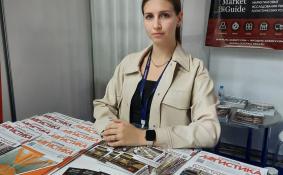
научно-практический
журнал

Новости редакции
Дорогие читатели! Представляем вашему вниманию первый номер журнала «ЛОГИСТИКА» в 2025 г. Прежде всего хотим обратить внимание читателей на нашего нового партнера R1 Development – девелоперскую компанию, которая создает среду нового поколения и специализируется на строительстве индустриально-логистической, коммерческой и жилой недвижимости. Один из проектов R1 Development – сеть индустриальных парков «Дружба».
Дорогие читатели! Представляем вашему вниманию заключительный номер журнала «ЛОГИСТИКА» в 2024 г. Мы постарались сделать его насыщенным и интересным.
Дорогие читатели! Представляем вашему вниманию 11-й номер журнала «ЛОГИСТИКА», где вы найдете актуальные материалы и статьи.
Статья недели:

ФОТО НЕДЕЛИ
ЦИТАТЫ
События в российской логистике
ULI / JLL Report: Non-Retail Tenants Continue to Boost Shopping Centre Performance
CANNES
A new report from the Urban Land Institute (ULI) and JLL finds that non-retail tenants - including food and beverage (F&B), leisure and community amenities – have led to 28% estimated rental value growth, a 7.24% increase in footfall and a 1ppt decrease in vacancy rates across 12 European shopping centres in the past 12 months.
The report, Trading Up: Dining, leisure, amenities, and the new shopping centre, is the second in a series commissioned by ULI’s European Retail and Entertainment Council to better understand the role of non-retail elements in the continued reinvention of shopping centres. It is informed by the analysis of 12 shopping centres across the UK, France, Poland and Spain that have recently upgraded or extended their centres to include additional non-retail tenants. The report also draws on insights from interviews with industry experts, as well as a survey of ULI members working in the retail sector. In addition to examining F&B and leisure, this year’s report looks at community amenities including healthcare, dentists, libraries, co-working spaces, and community uses.
Christian Luft, director of valuation advisory at JLL, commented, “It’s now more important than ever that shopping centres provide that exciting, innovative space that people want to come to, spend time and money in, and return to. The survey’s findings are encouraging and build on what we found last year, that non-retail offerings add value to modern shopping centres. Getting the tenant mix right helps to create successful retail destinations which thrive, benefitting consumers, retailers and landlords alike.”
58% of the survey respondents reported that the addition of F&B, leisure, and community amenities has had a positive impact on the financial performance of shopping centres. As in last year’s survey, respondents indicated that increased dwell time (the time a consumer spends in a centre) and footfall are the two most important contributions non-retail offerings can make to shopping centres. However, this year’s survey found non-retail tenants’ roles in supporting overall retail sales and rental income to be almost equally important. This suggests that there are increasing expectations around how non-retail tenants can contribute to a shopping centre’s bottom line.
“Over the past year or so, we have seen how F&B, leisure, and community amenities have become such a strong focus of attention in the industry – from the perspective of the landlord to that of the operator,” said Chris Igwe, co-chair of the ULI Europe Retail and Entertainment Council. “Today, as questions are asked about the future and sustainability of non-retail tenants as a viable long-term offer, this report not only provides interesting insights, but also explores what we are learning and what we should be cautious about going forward.”
Marije Braam-Mesken, co-chair of the ULI Europe Retail and Entertainment Council, added, “While the results of the survey show that non-retail uses are indeed contributing to the success of centres, it has also become clear that it is not always easy to get the right size and tenant mix.”
The report also includes several case studies that examine how shopping centres around the globe are implementing non-retail offerings.
















